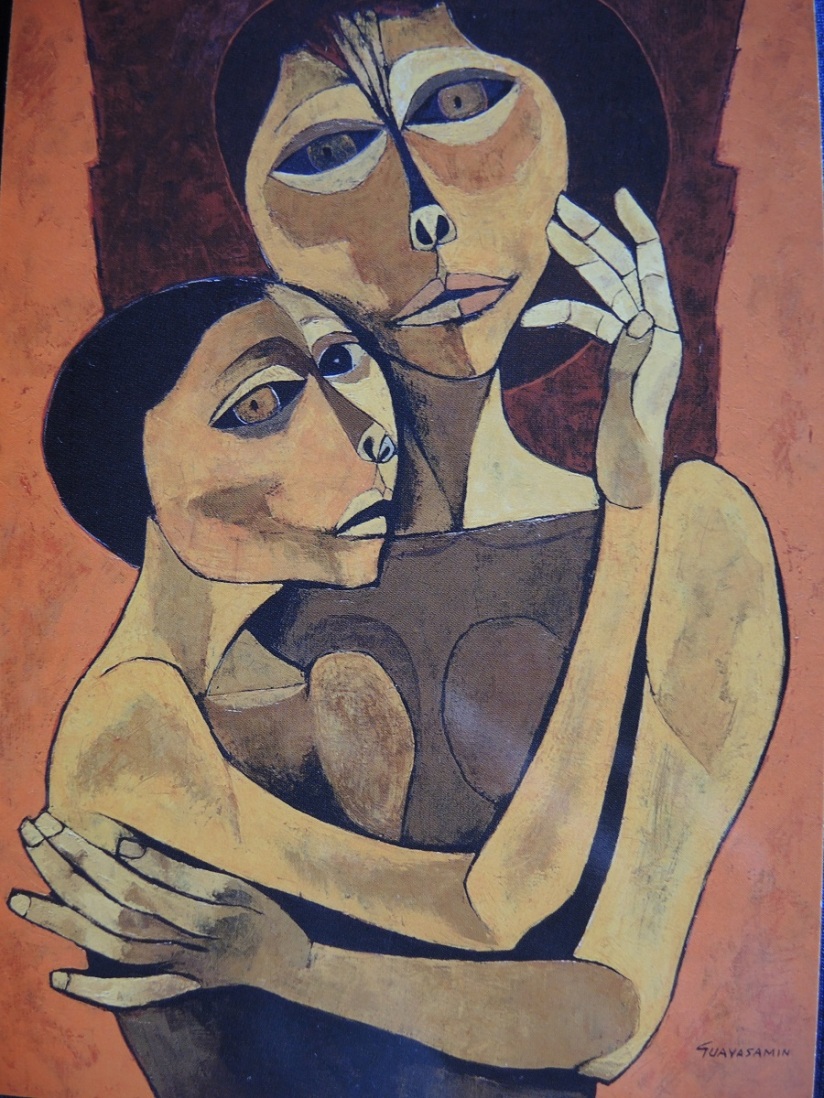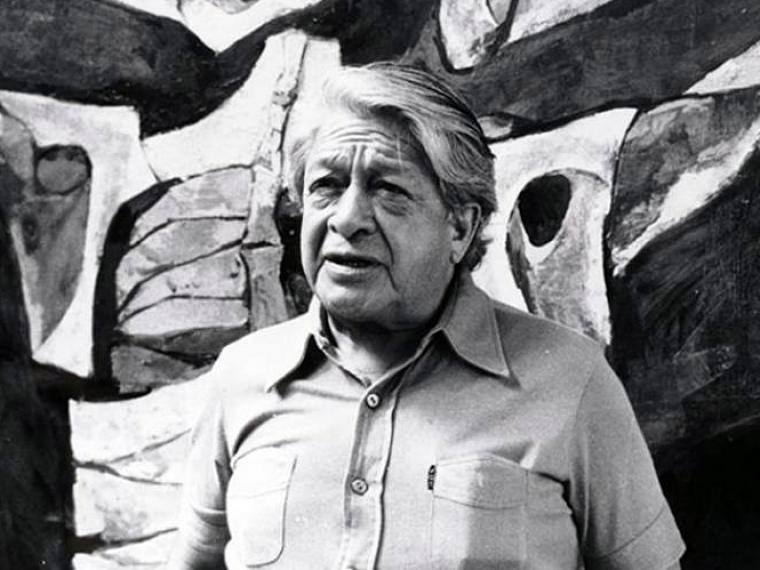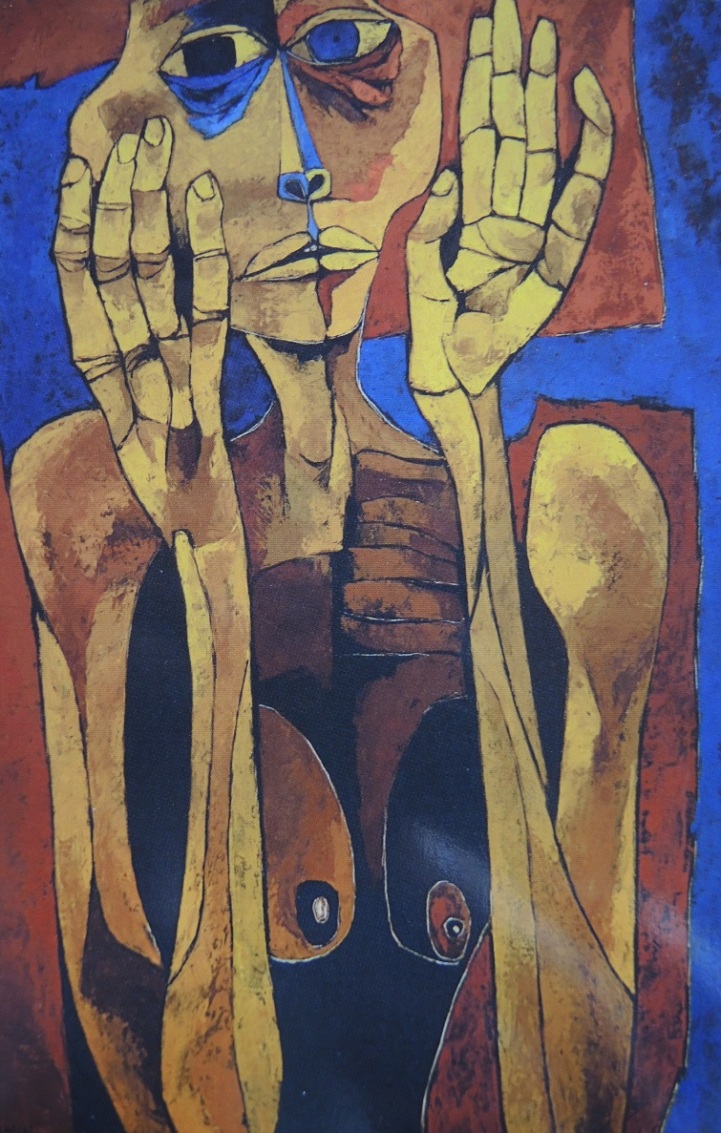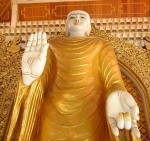
According to Pablo Guayasamín, the artist’s son, Mestizaje, is a painting that represents a young woman with great strength and spirit, a mixture of Spanish and the indigenous Indian races. She further represents the resurrection of a new race that is more humanitarian, has a better comprehension of its times, has values different from the ones we have and that is much less confrontational. She has better understanding and respects the thoughts of others. Photo Credit: Henry Lewis
Oswaldo Guayasamín is an Ecuadorian painter and sculptor whose work tells the story of prejudice, abuse and the suffering of indigenous peoples all across Latin America. His personal observations of institutionalized poverty, the horrors of war and violent revolutions during the 20th century all had a profound influence on his work.

Madre y Niño, 1985. The theme of motherhood is repeated in many of Guayasamín’s paintings. He had a deep reverence for his own mother and for the major role indigenous women play within their families and communities. Photo Credit: Henry Lewis
Early Life
Guayasamín was the first of ten children born to an indigenous (Quechua-speaking) father and mestiza (mixed race) mother in Ecuador’s capital, Quito, on July 6, 1919. Being the eldest child of a poor family brought hardships and meant he had to assume a great deal of responsibility at a young age. Even so, he found time to draw and paint and his artistic talents were recognized at an early age.
When he was old enough, he worked as both a taxi and a truck driver to help support himself and his family while he also attended Quito School of Art, where he studied painting, sculpting and architecture. During this time, his best friend was killed in a political demonstration in Quito. This tragic incident, along with his indigenous heritage and family poverty, would stay with him for the rest of his life and deeply impact his world view and the imagery he painted.

Maternidad, 1987. Another of Guayasamín’s mother and child series. Photo Credit: Henry Lewis
“Guayasamín is one of the last crusaders of imaginismo [imagism]. He is a creator of humanity in its broadest sense, of the living and historical imagination. His universe is sustaining although it threatens us like a cosmic disaster. Think before approaching his painting because it will not be easy to withdraw.”
-Pablo Neruda, Chilean poet and Nobel Prize winner for Literature

Oswaldo Guayasamín, pictured here in his later years, standing in front of one of his typically large paintings. Photo Credit: Wiki
Career
In 1940, Guayasamín had his first solo gallery show which was well-received due to his expressionist style that distinguished him from other Ecuadorian artists. Quite by chance, New York philanthropist and art collector Nelson Rockefeller saw one of his early exhibitions, purchased multiple paintings and further rewarded him with a fellowship to work and study in the USA. From this point forward, Guayasamín’s career took flight. During his lifetime, he had 181 individual exhibits in Latin America, the USA and Europe.
His talents were recognized by both his peers and the artistic establishment. He won the first prize at the Third Hispano-American Biennial of Art in Barcelona, Spain in 1955. In 1957, he was named the best South American painter at the Fourth Biennial of São Paulo, Brazil. He was given an award for “an entire life of work for peace” by the United Nations Educational, Scientific and Cultural Organization (UNESCO).

Meditación, 1993. One of Guayasamín’s trademarks is his expressive use of hands and fingers which represent the manual labor and suffering of indigenous people. Photo Credit: Henry Lewis

Lagrimas De Sangre (Tears of Blood), 1973. Much of Guayasmín’s earlier work often depicts traumatized figures who appear to be lost in a hellish world. This represents the artist’s great emotional attachment to his indigenous heritage and the “3,000 years of suffering” to which he often referred. Photo Credit: Henry Lewis

Rostros de América (Faces of America),1996. Photo Credit: Henry Lewis
Guayasamín was a friend of the great Mexican muralist José Clemente Orozco and they traveled Latin America together, studying the lives and art of indigenous communities all around the continent. Guayasamín had a great respect for indigenous traditions and the history and craftsmanship that he recognized in art produced in the region. When he became financially successful, he began collecting pre-Columbian art and artifacts and amassed an impressive collection which can now be seen in his house museum in Quito.

Guayasamín’s former home in Quito is now a museum showing his work as well as the artist’s collection of Pre-Columbian art. It’s also the home of the Guayasamín Foundation which was set up by the artist and his children to continue his artistic and humanitarian work. Photo Credit: Henry Lewis

A bronze sculpture by Guayasamín that stands just outside the main entrance to the Guayasamín Museum, La Capilla del Hombre (The Chapel of Man), in the hills above central Quito. Photo Credit: Henry Lewis

La Capilla del Hombre, a purpose built museum designed by Guayasamín and constructed adjacent to his house museum and foundation headquarters in Quito. Work began on the project in 1995, but unfortunately the artist died of a heart attack on a trip to the USA in 1999 so didn’t get to see the project’s completion in 2002. Photo Credit: Henry Lewis
Not as well-known outside his home country as Latin American artists Diego Rivera and his friend Orozco, Guayasmín was nevertheless revered by other Latin American artists of his time for his humanitarian ideals and work.
“He was a man of Latin American conviction and a fighter for democracy. His work reflects his deep commitment to social progress and to people who have been ignored and exploited…His memory will stay with us and will be a permanent encouragement for those who seek a better future for humanity.”
-Rigoberta Menchú, Nobel Peace Prize Winner

Madre y Niño, 1989. Another in the series of mother and child paintings that Guayasamín was so found of. Photo Credit: Henry Lewis
I was mesmerized the first time I saw a Guayasamín print adorning the wall of my room at a guesthouse in northern Ecuador. Since then, I’ve become a huge fan of the work of one of South America’s most important 20th century artists. If you find yourself in Quito, I highly recommend a visit to the Guayasamín House Muesum as well as La Capilla del Hombre, both of which are included in the price of an entrance ticket. You won’t regret it!
peace~henry



I can’t thank you enough for introducing me to the work of this amazing artist. The passion and emotion just pour from the work. I hope it’s okay that I reblog your post. Thank you again.
LikeLiked by 3 people
Of course, thank you for reposting. Many of Guayasamín’s canvasses are quite large in scale so their impact and power is magnified when viewing them in person.
LikeLike
I can only imagine. Amazing artist.
LikeLiked by 1 person
Grest post, Henry. Thanks for the introduction to this artist and his wonderful work. Good stuff.
LikeLiked by 2 people
It’s always fun for me to discover new artists whose work has had a positive impact on the lives of others. It makes me very happy to be able to share Guayasamín’s work with others.
LikeLiked by 1 person
While I’m familiar with the work of Orozco here in Mexico, this artist is new to me. Interesting that the two of them traveled together as well.
LikeLiked by 2 people
Thanks for your comments. I want to return to Mexico to see more of Orozco’s work too!
LikeLike
Henry, thanks for bringing Guayasamín’s work to our attention. His paintings are emotive and powerful.
LikeLiked by 3 people
You are so welcome Rosaliene. Guayasamín is quite well known in Ecuador but not so much in other regions. His work really spoke to me the first time I saw it and I believe he and his foundation have done a great deal to instill confidence in many of Ecuador’s indigenous communities.
LikeLiked by 1 person
Very impressive art by Oswaldo Guayasamín, who I was unaware of until now. I hope to visit Quito at the end of this year or beginning of next and will make a point of visiting the Guayasamín House Muesum & La Capilla del Hombre. Thanks for the heads-up!
Jean-Jacques
LikeLiked by 2 people
I’m sure you will enjoy seeing Guayasamín’s work and learning more about his life. His often painted quite large canvasses which makes his images even more powerful when seen live. Thanks for reading and commenting!
LikeLiked by 1 person
Very striking images, with Rostros De America and Lagrimas De Sangre my favourites. Thanks Henry.
LikeLiked by 2 people
Very welcome Marios. Glad you enjoyed the images.
LikeLike
A truly remarkable artist, I thank you for the ‘introduction.’
LikeLiked by 2 people
Happy to and glad you enjoyed. I find his paintings to be incredibly powerful.
LikeLiked by 1 person
Gorgeous paintings and a poignant review. Art that became a voice and visibility for the dispossessed.
LikeLiked by 2 people
Thanks for your kind words. I was impressed by the sense of generosity instilled in Guayasamín’s children. Instead of selling his magnificent house and works of art, they chose to donate all the financial wealth he had accumulated to his foundation in order to have a positive impact on the community. Those values seem to be out of style in this day and age.
LikeLike
Henry, I may visit Quito towards the end of this year or early next year and will make a point of visiting Guayasamín House Museum and La Capilla del Hombre. Oswaldo Guayasamín’s work is very impressive – thank you for the heads-up.
(PS: I left a comment from my other blog profile on this post, but it seems to still be in moderation, can you check? Thanks!).
LikeLiked by 2 people
I highly recommend a visit to both venues. The location of both museums is high up in the hills above central Quito so I would recommend taking a taxi from your hotel. Any driver will know the location. Thanks for reading!
LikeLiked by 1 person
Thanks for the tip!
LikeLiked by 1 person
I looked at the paintings and thought Latino Picasso.
LikeLiked by 2 people
Definitely Ken. I remember reading something in the house museum about Guayasamín and Picasso, but I don’t recall if they were friends or if it was simply stating Picasso’s influence on Guayasamín’s painting style. It was probably written in Spanish and at the time I was only able to decipher the obvious words 🙂
LikeLiked by 1 person
VERY INTERESTING – HIS ART IS POWERFUL ESPECIALLY THE HANDS AND MOTHER/CHILD IMAGES – AND MOST IMPORTANTLY HIS MOTIVES AND ACTIONS TO IMPROVE HUMANITY/INDIGENOUS PEOPLES – SPEAKS WELL THAT HIS FAMILY CHOSE TO USE WHAT HE AMASSED FOR GOOD.
LikeLiked by 2 people
Yes, I think it’s wonderful that Guayasamín’s children all agreed on the importance of preserving the memory of their father over quick profits, as well as their interest in carrying on his work with the indigenous communities of Ecuador. Thanks for sharing your thoughts!
LikeLike
Thank you for introducing me to this wonderful artist! I love what I’ve seen here, and you did a fabulous bio plus to go with it! Wonderful!
LikeLiked by 2 people
Thank you Resa! I find Guayasamín’s work to be incredibly powerful.
LikeLiked by 1 person
Fabulous!
LikeLiked by 1 person
Gracias Cassie!
LikeLike